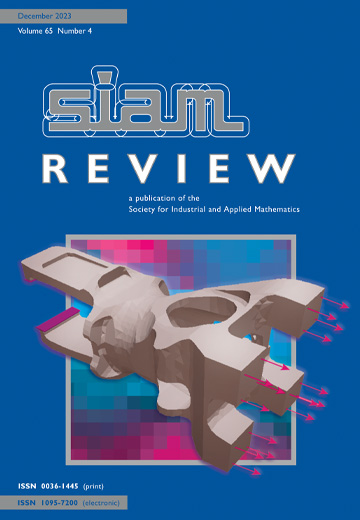Optimal Survival Strategies for Diffusive Flows: A Schrödinger Bridge Approach to Unbalanced Transport
IF 6.1
1区 数学
Q1 MATHEMATICS, APPLIED
引用次数: 0
Abstract
SIAM Review, Volume 67, Issue 3, Page 579-604, August 2025.Abstract.Diffusive flows, and their discrete counterparts, are ubiquitous in the physical and engineering sciences. In many important examples, the total mass is not preserved and therefore standard probabilistic models are not suitable. Examples include electrons which may be absorbed by the medium in which they travel. In population genetics, some individuals may “disappear” due to their genotype. In traffic flows over a network, some vehicles might simply exit the circulation and park. In this more general situation, where some of the mass may be lost, it is of particular interest to reconcile the observed initial and final marginal distributions with a given prior. In the case when the two marginals are probability distributions, and thus of equal mass, this problem was posed and, to a considerable extent, solved by E. Schrödinger in 1931/32. It is now known as the Schrödinger Bridge Problem (SBP). It turns out that Schrödinger’s problem can be viewed as both a modeling and a control problem. Due to the fundamental significance of this problem, interest in the SBP and in its deterministic (zero-noise limit) counterpart of optimal mass transport (OMT) has in recent years enticed scientists from a broad spectrum of disciplines, including physics, stochastic control, computer science, probability theory, and geometry. Yet, while the mathematics and applications of SBP/OMT have been developing at a considerable pace, accounting for marginals of unequal mass has received scant attention. The problem of interpolating between “unbalanced” marginals has been approached by introducing source/sink terms into the transport equations in an ad hoc manner, chiefly driven by applications in image registration. Nevertheless, as hinted at above, losses are inherent in many physical processes and, thereby, models that account for lossy transport may also need to be reconciled with observed marginals following Schrödinger’s quest, that is, to adjust the probability of trajectories of particles, including those that do not make it to the terminal observation point, so that the updated evolution represents the most likely way that particles may have been transported, or vanished, at some intermediate point. Thus, the purpose of this work is to develop such a natural generalization of the SBP for diffusive evolution with losses, whereupon particles are “killed” (jump into a coffin/extinction state) according to a probabilistic law, and thereby mass is gradually lost along their stochastically driven flow. Through a suitable embedding, which appears to be novel, we turn the problem into an SBP for stochastic processes that combine diffusive and jump characteristics. Then, following a large-deviations formalism in the style of E. Schrödinger, given a prior law that allows for losses, we ask for the most probable evolution of particles along with the most likely killing rate as the particles transition between the specified marginals. Our approach differs sharply from previous work involving a Feynman–Kac multiplicative reweighing of the reference measure. The latter, as we argue, is far from Schrödinger’s quest. An iterative scheme, generalizing the celebrated Fortet–IPF–Sinkhorn algorithm, permits the computation of the new drift and the new killing rate of the path-space solution measure. We also formulate and solve a related fluid-dynamic control problem for the flow of one-time marginals where both the drift and the new killing rate play the role of control variable. A numerical example illustrating the new theoretical results is also presented.
扩散流的最优生存策略:不平衡运输的Schrödinger桥式方法
SIAM评论,第67卷,第3期,第579-604页,2025年8月。摘要。扩散流和离散流在物理和工程科学中无处不在。在许多重要的例子中,总质量没有被保留,因此标准的概率模型是不合适的。例子包括电子可能被它们所处的介质所吸收。在群体遗传学中,一些个体可能由于其基因型而“消失”。在网络上的交通流中,一些车辆可能只是退出流通并停放。在这种更一般的情况下,其中一些质量可能会损失,使观测到的初始和最终边际分布与给定的先验相协调是特别有趣的。在两个边际是概率分布的情况下,因而质量相等,这个问题是E. Schrödinger在1931/32年提出的,并在很大程度上得到了解决。它现在被称为Schrödinger桥梁问题(SBP)。事实证明,Schrödinger的问题既可以看作是建模问题,也可以看作是控制问题。由于这一问题的根本意义,近年来,对SBP及其最优质量输运(OMT)的确定性(零噪声限制)对应的兴趣吸引了来自广泛学科的科学家,包括物理学、随机控制、计算机科学、概率论和几何。然而,虽然SBP/OMT的数学和应用一直在以相当快的速度发展,但计算不相等质量的边缘却很少受到重视。通过在传输方程中引入源/汇项,以一种特别的方式解决了“不平衡”边缘之间的插值问题,主要是由图像配准中的应用驱动的。然而,正如上面所暗示的,损失是许多物理过程中固有的,因此,考虑到有耗输运的模型也可能需要与Schrödinger的探索所观察到的边际相协调,也就是说,调整粒子轨迹的概率,包括那些没有到达最终观测点的轨迹,以便更新的演化代表粒子可能被传输或消失的最有可能的方式。在某个中间点。因此,这项工作的目的是发展具有损失的扩散演化的SBP的这种自然推广,因此粒子根据概率定律被“杀死”(跳入棺材/灭绝状态),因此质量沿着它们随机驱动的流动逐渐损失。通过一种新颖的合适的嵌入方法,我们将该问题转化为具有扩散和跳跃特性的随机过程的SBP。然后,遵循E. Schrödinger风格的大偏差形式,给定允许损失的先验定律,我们要求粒子的最可能进化以及粒子在指定边缘之间过渡时最可能的杀死率。我们的方法与先前涉及费曼-卡茨乘法重估参考测量的工作有很大不同。我们认为,后者远非Schrödinger的追求。一个迭代方案,推广著名的Fortet-IPF-Sinkhorn算法,允许计算新的漂移和新的路径空间解测度的扼杀率。本文还提出并求解了以漂移和新压井率为控制变量的一次性边缘流的相关流动力控制问题。最后给出了一个数值算例来说明新的理论结果。
本文章由计算机程序翻译,如有差异,请以英文原文为准。
求助全文
约1分钟内获得全文
求助全文
来源期刊

SIAM Review
数学-应用数学
CiteScore
16.90
自引率
0.00%
发文量
50
期刊介绍:
Survey and Review feature papers that provide an integrative and current viewpoint on important topics in applied or computational mathematics and scientific computing. These papers aim to offer a comprehensive perspective on the subject matter.
Research Spotlights publish concise research papers in applied and computational mathematics that are of interest to a wide range of readers in SIAM Review. The papers in this section present innovative ideas that are clearly explained and motivated. They stand out from regular publications in specific SIAM journals due to their accessibility and potential for widespread and long-lasting influence.
 求助内容:
求助内容: 应助结果提醒方式:
应助结果提醒方式:


